TICLE: Tangible Interfaces for Collaborative Learning Environments
 Tangible Interfaces for Collaborative Learning Environments (TICLE) strives to find new ways of helping children to learn math and science concepts, with computers enhancing – yet not becoming the focus of – the learning experience. With tangible user interfaces, the computer can "watch" as children work collaboratively on puzzles or with other educational manipulatives in a physical environment. The computer system may then act as a "guide on the side" that provides the sort of encouragement and prodding that a teacher would. This builds on children's innate love of puzzles, their collaborative tendencies, and their inclination to learn by doing. Although such a system cannot replace a qualified teacher, it can help teachers to motivate and reach more students simultaneously. This is especially true if teachers are given the tools to build their own collaborative learning experiences with tangible interfaces, for instructors will then be empowered to virtually duplicate themselves.
Tangible Interfaces for Collaborative Learning Environments (TICLE) strives to find new ways of helping children to learn math and science concepts, with computers enhancing – yet not becoming the focus of – the learning experience. With tangible user interfaces, the computer can "watch" as children work collaboratively on puzzles or with other educational manipulatives in a physical environment. The computer system may then act as a "guide on the side" that provides the sort of encouragement and prodding that a teacher would. This builds on children's innate love of puzzles, their collaborative tendencies, and their inclination to learn by doing. Although such a system cannot replace a qualified teacher, it can help teachers to motivate and reach more students simultaneously. This is especially true if teachers are given the tools to build their own collaborative learning experiences with tangible interfaces, for instructors will then be empowered to virtually duplicate themselves.
TICLE Table
The TICLE Table is a workspace for children. Along the backside of the table, a computer screen gives the children prompts, hints, and encouragement. A touch screen enables the children to request further information or help. A simple web cam, surrounded by fluorescent lights, is mounted at the center of the base, pointing up. A sheet of opaque plastic (with a center hole for the camera to look through), placed directly above the camera and lights, helps to scatter the light. The top of the table is a sheet of frosted Plexiglas. The table itself could be constructed out of almost anything; for example, I made a portable TICLE table out of a metal cart with wheels (with a 18”x24” top) and cut the wire mesh out of the top two shelves.
Tagging Strategies

Four different types of visual tags are used to mark puzzle pieces and manipulative used with the TICLE table. Space-filling tags mark pieces that are composed of multiples of some basic unit shape. Color represents the type of the piece. Examples are pattern blocks (composed of triangles) and pentominoes (composed of squares). Orientation tags use 3 colinear colored spots to represent the type, location, and orientation of a piece. These are used to mark the tangram pieces. Binary attribute tags are used to answer yes/no questions. In the binary dichotomous sorting application, colors represent different attributes of an object. Tri-colored bi-directional barcodes represent attributes with a range of values. The background color identifies the attribute itself. All 4 types of tags are recognized with the Anna Xtra, which can be used in a Macromedia Director application (PC version 8 and up only).
TICLE Table Applications
 |
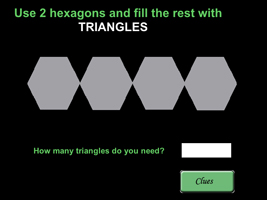 |
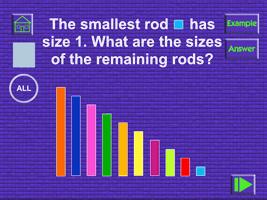 |
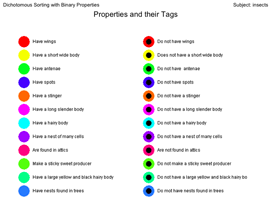 |
| The Tangram teaches geometry concepts to children. Given a set of wooden Tangram puzzle pieces, students can solve one of three puzzles. Hints have children experiment with a subset of the puzzle, to discover how various shapes can be constructed using smaller shapes, or by simply rotating existing shapes. |
The Pattern Blocks teach children geometry concepts. Students are asked to fill in a pattern using one or more types of shapes, which are all derived from equilateral triangles. Through the activities, children discover the geometric relationships between these pieces. The computer checks that the correct pieces are being used. Hints stress the similarities and differences between the pieces. |
The Cuisenaire Rods teach children about numeric relationships, such as greater than, less than, odd, and even. Children do the simple exercises that are provided, or test their understanding by solving several space-filling puzzles where the solution must be filled with either all odd- or all even-length rods. |
Dichotomous Sorting has children select science specimens with common attributes. Real specimens are used so that children can compare texture, weight, hardness … all attributes that are difficult to gauge on a computer screen. A separate teacher’s interface is used to define the types of specimens and their attributes. Teachers can also add their own web-based hints. |
3D Applications
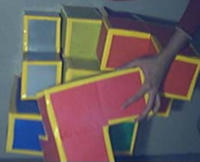 We also experimented with 3D puzzles. In our first experiment, we used stereo computer vision to track the pieces of a Soma Cube. Colors identify the pieces; reflective tape marks the edges. Image colors are converted to YUV. The chrominance (UV) values determine which puzzle pieces the corners correspond to. We find corners in the images by applying a Sobel gradient filter and Harris corner detection to the Y (luminance) channel. We then correlate the corners in the stereo images to derive 3D coordinates. These coordinates are translated, rotated, and scaled to obtain the best match with an internal representation of the puzzle piece, which yields its orientation.
We also experimented with 3D puzzles. In our first experiment, we used stereo computer vision to track the pieces of a Soma Cube. Colors identify the pieces; reflective tape marks the edges. Image colors are converted to YUV. The chrominance (UV) values determine which puzzle pieces the corners correspond to. We find corners in the images by applying a Sobel gradient filter and Harris corner detection to the Y (luminance) channel. We then correlate the corners in the stereo images to derive 3D coordinates. These coordinates are translated, rotated, and scaled to obtain the best match with an internal representation of the puzzle piece, which yields its orientation.
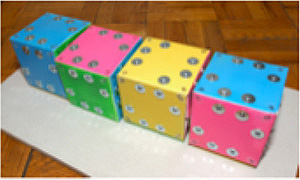 In our second experiment, we used sensors within the puzzle pieces to detect their condition. Each puzzle piece contains a Basic Stamp, current sensors, and a radio frequency (RF) transceiver. A current sensor detects when a circuit is completed by two puzzle pieces touching. By placing distinct resistors at each possible circuit, we can tell which sides of which pieces are adjacent to each other. With additional resistors, we can detect relative orientation as well. This adjacency information is transmitted to the computer via the RF transceiver. The setup of the leads on the outside of the pieces ensures that every adjacency will be sensed by the two pieces.
In our second experiment, we used sensors within the puzzle pieces to detect their condition. Each puzzle piece contains a Basic Stamp, current sensors, and a radio frequency (RF) transceiver. A current sensor detects when a circuit is completed by two puzzle pieces touching. By placing distinct resistors at each possible circuit, we can tell which sides of which pieces are adjacent to each other. With additional resistors, we can detect relative orientation as well. This adjacency information is transmitted to the computer via the RF transceiver. The setup of the leads on the outside of the pieces ensures that every adjacency will be sensed by the two pieces.
Outreach
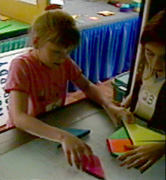
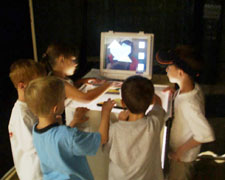 The TICLE Tangram prototype has been installed at the Goudreau Museum of Mathematics in Art and Science and the San Antonio Children’s Museum.
The TICLE Tangram prototype has been installed at the Goudreau Museum of Mathematics in Art and Science and the San Antonio Children’s Museum.
Publications
A. Mbogho , L. Scarlatos, M. Jaworska (2006). Teaching with Tangibles: A Tool for Defining Dichotomous Sorting Activities. Proceedings of ACM CHI-SA 2006 (5th Southern African Conference on Human-Computer Interaction), January 2006, 59-64.
L. Scarlatos, A. Bruckman, A. Druin, M. Eisenberg, M. Lenore, O. Zuckerman (2005). Connecting with Kids: So What’s New? CHI 2005 Extended Abstracts, Conference on Human Factors in Computer Systems, Portland, OR, April 2005, 1172-1173.
L.L. Scarlatos (2002). TICLE: Using Multimedia Multimodal Guidance to Enhance Learning, Information Sciences 140 (2002), 85-103.
L.L. Scarlatos (2002). An Application of Tangible Interfaces in Collaborative Learning Environments, SIGGRAPH 2002 Conference Abstracts and Applications, 125-126.
L. Scarlatos, S. Landy and S. Qureshi (2002). Tracking 3D Puzzle Pieces for Collaborative Learning Environments, SIGGRAPH 2002 Conference Abstracts and Applications, 270.
L.L. Scarlatos, S.S. Landy, J. Breban, R. Horowitz, and C. Sandberg (2002). On the Effectiveness of Tangible Interfaces in Collaborative Learning Environments, CUNY Graduate Center Technical Report TR-200204.
L.L. Scarlatos, S.S. Landy, S. Qureshi (2002). Ubiquitous Puzzle Pieces: 3D Tangible Interfaces for Collaborative Learning Environments, CUNY Graduate Center Technical Report TR-200207.
L.L. Scarlatos and S.S. Landy (2001). Experiments in Using Tangible Interfaces to Enhance Collaborative Learning Experiences, CHI 2001 Extended Abstracts, Conference on Human Factors in Computer Systems, March 31 - April 5, 2001, 257-258.
L.L. Scarlatos, Y. Dushkina, S. Landy (1999). TICLE: A Tangible Interface For Collaborative Learning Environments, CHI 99 Extended Abstracts, 260-261.
L.L. Scarlatos (1999). Puzzle Piece Topology: Detecting Arrangements in Smart Object Interfaces, Proceedings of the 7th International Conference in Central Europe on Computer Graphics, Visualization and Interactive Digital Media '99, 456-462.
People
This effort is being led by Dr. Lori L. Scarlatos (Lori.Scarlatos AT stonybrook.edu), associate professor at Stony Brook University (formerly at Brooklyn College). Student participants include Shalva Landy, Saira Qureshi, Michelle Douglas, Magdalena Jaworska, Julia Breban, Robin Horowitz, Chani Sandberg, Abraham Lebovits, and Yulia Dushkina, and Audrey Mbogho. Tony Scarlatos also contributed significantly to the design and construction of the TICLE table.
This material is based upon work supported by the National Science Foundation under awards 9984385 and 0203333. Any opinions, findings, and conclusions or recommendations expressed in this material are those of the author and do not necessarily reflect the views of the National Science Foundation.
 Tangible Interfaces for Collaborative Learning Environments (TICLE) strives to find new ways of helping children to learn math and science concepts, with computers enhancing – yet not becoming the focus of – the learning experience. With tangible user interfaces, the computer can "watch" as children work collaboratively on puzzles or with other educational manipulatives in a physical environment. The computer system may then act as a "guide on the side" that provides the sort of encouragement and prodding that a teacher would. This builds on children's innate love of puzzles, their collaborative tendencies, and their inclination to learn by doing. Although such a system cannot replace a qualified teacher, it can help teachers to motivate and reach more students simultaneously. This is especially true if teachers are given the tools to build their own collaborative learning experiences with tangible interfaces, for instructors will then be empowered to virtually duplicate themselves.
Tangible Interfaces for Collaborative Learning Environments (TICLE) strives to find new ways of helping children to learn math and science concepts, with computers enhancing – yet not becoming the focus of – the learning experience. With tangible user interfaces, the computer can "watch" as children work collaboratively on puzzles or with other educational manipulatives in a physical environment. The computer system may then act as a "guide on the side" that provides the sort of encouragement and prodding that a teacher would. This builds on children's innate love of puzzles, their collaborative tendencies, and their inclination to learn by doing. Although such a system cannot replace a qualified teacher, it can help teachers to motivate and reach more students simultaneously. This is especially true if teachers are given the tools to build their own collaborative learning experiences with tangible interfaces, for instructors will then be empowered to virtually duplicate themselves. 




 We also experimented with 3D puzzles. In our first experiment, we used stereo computer vision to track the pieces of a Soma Cube. Colors identify the pieces; reflective tape marks the edges. Image colors are converted to YUV. The chrominance (UV) values determine which puzzle pieces the corners correspond to. We find corners in the images by applying a Sobel gradient filter and Harris corner detection to the Y (luminance) channel. We then correlate the corners in the stereo images to derive 3D coordinates. These coordinates are translated, rotated, and scaled to obtain the best match with an internal representation of the puzzle piece, which yields its orientation.
We also experimented with 3D puzzles. In our first experiment, we used stereo computer vision to track the pieces of a Soma Cube. Colors identify the pieces; reflective tape marks the edges. Image colors are converted to YUV. The chrominance (UV) values determine which puzzle pieces the corners correspond to. We find corners in the images by applying a Sobel gradient filter and Harris corner detection to the Y (luminance) channel. We then correlate the corners in the stereo images to derive 3D coordinates. These coordinates are translated, rotated, and scaled to obtain the best match with an internal representation of the puzzle piece, which yields its orientation. In our second experiment, we used sensors within the puzzle pieces to detect their condition. Each puzzle piece contains a Basic Stamp, current sensors, and a radio frequency (RF) transceiver. A current sensor detects when a circuit is completed by two puzzle pieces touching. By placing distinct resistors at each possible circuit, we can tell which sides of which pieces are adjacent to each other. With additional resistors, we can detect relative orientation as well. This adjacency information is transmitted to the computer via the RF transceiver. The setup of the leads on the outside of the pieces ensures that every adjacency will be sensed by the two pieces.
In our second experiment, we used sensors within the puzzle pieces to detect their condition. Each puzzle piece contains a Basic Stamp, current sensors, and a radio frequency (RF) transceiver. A current sensor detects when a circuit is completed by two puzzle pieces touching. By placing distinct resistors at each possible circuit, we can tell which sides of which pieces are adjacent to each other. With additional resistors, we can detect relative orientation as well. This adjacency information is transmitted to the computer via the RF transceiver. The setup of the leads on the outside of the pieces ensures that every adjacency will be sensed by the two pieces.
 The TICLE Tangram prototype has been installed at the Goudreau Museum of Mathematics in Art and Science and the San Antonio Children’s Museum.
The TICLE Tangram prototype has been installed at the Goudreau Museum of Mathematics in Art and Science and the San Antonio Children’s Museum.